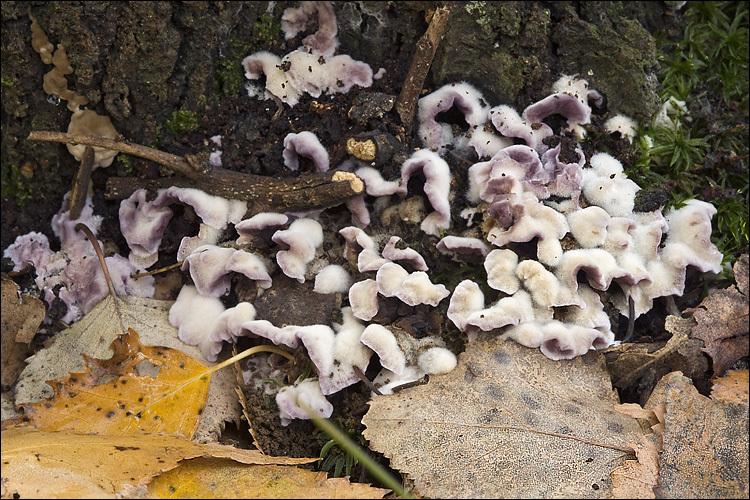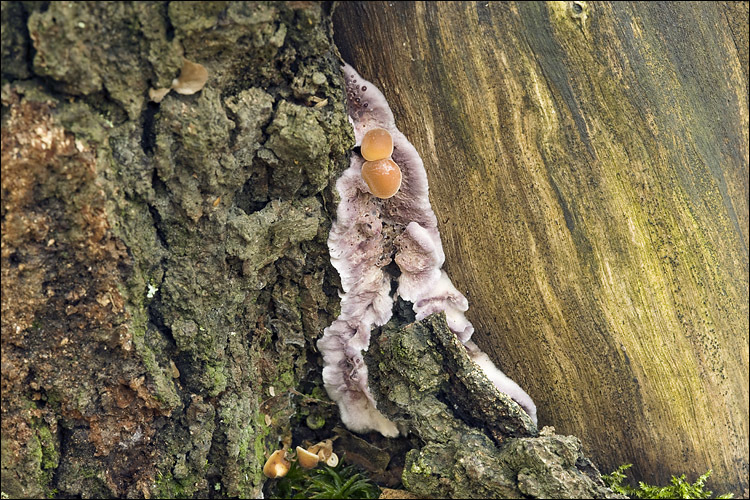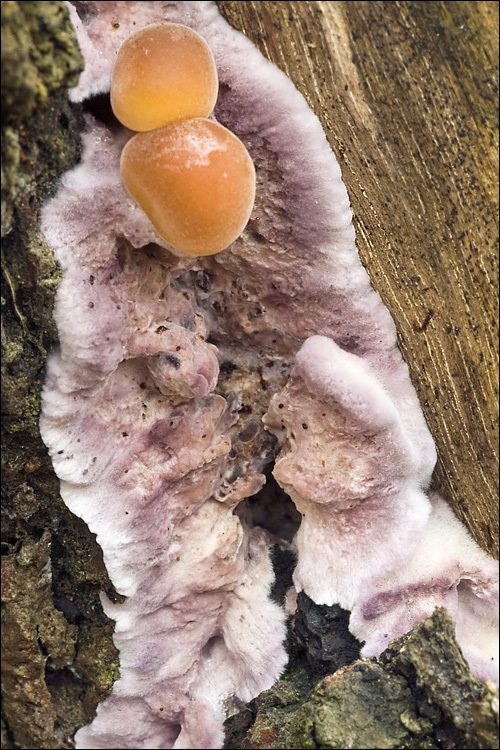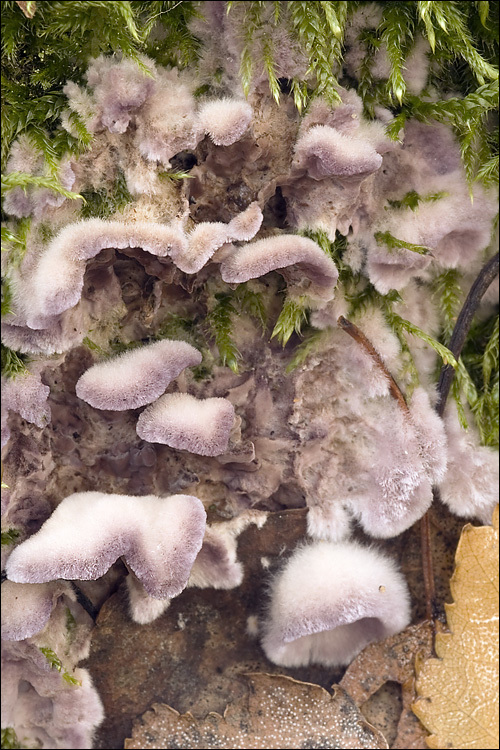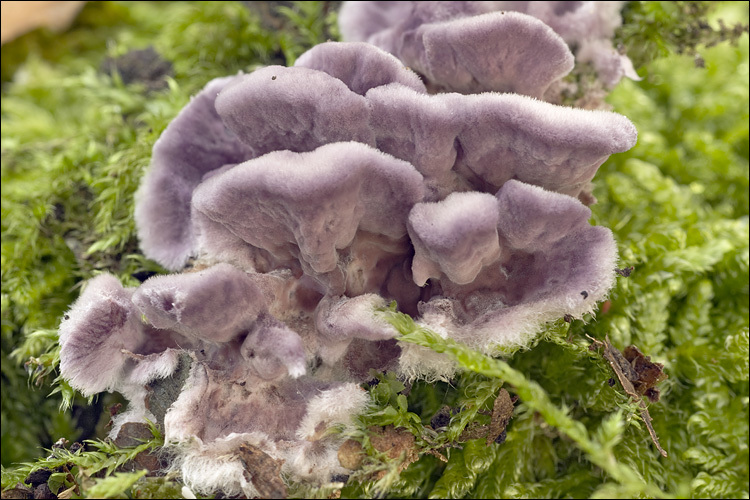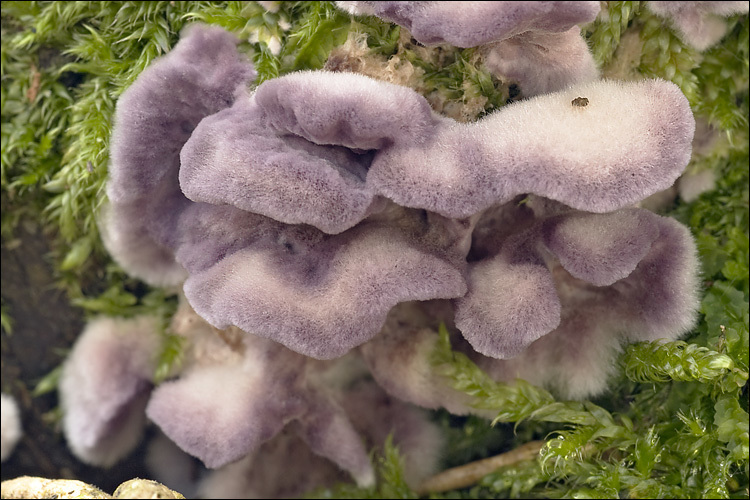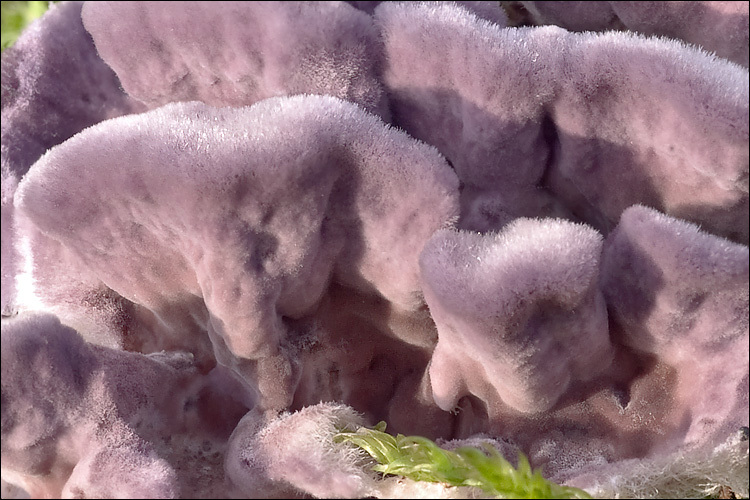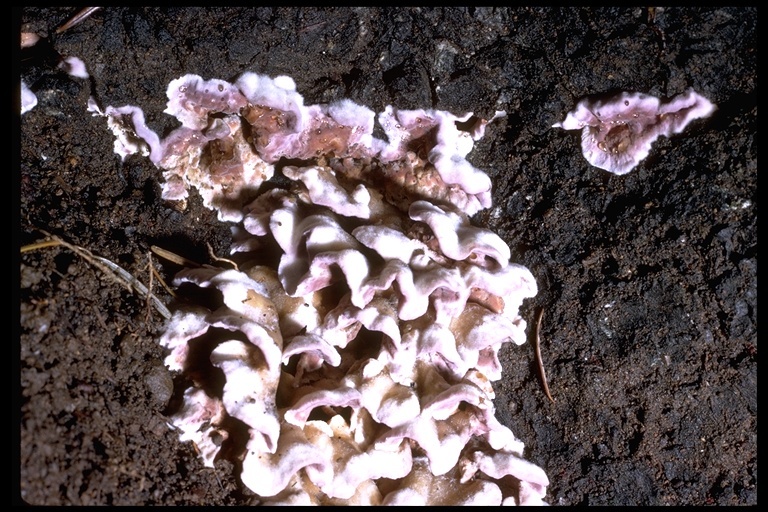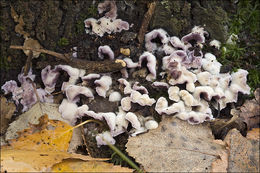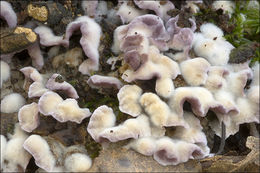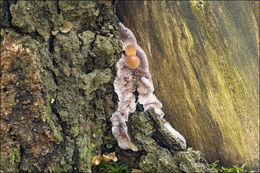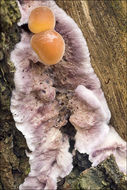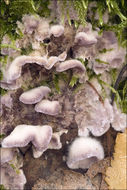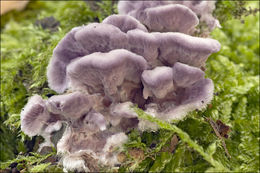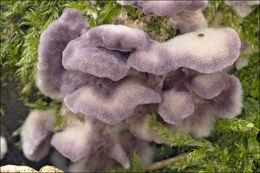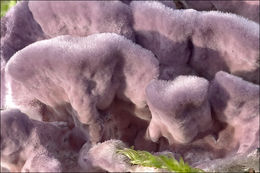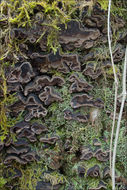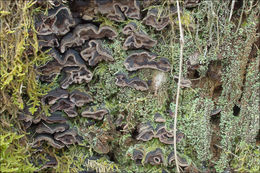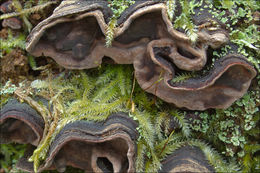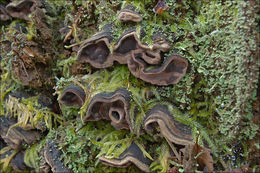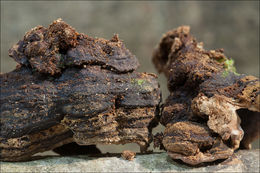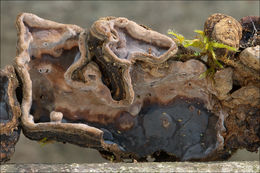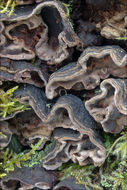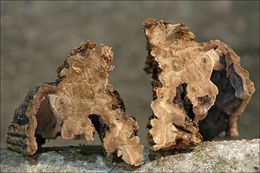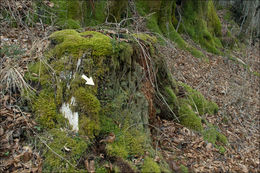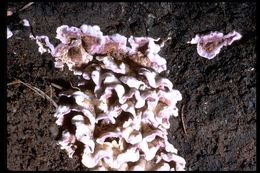-
Slo.: krlatni skladovec - Habitat: Mixed forest with dominant Betula pendula and Picea abies, flat ground, cretaceous clastic rock (flysh), in shade, partly protected from direct rain by tree canopies, average precipitations ~3.000 mm/year, average temperature 8-10 deg, elevation 560 m (1.840 feet), alpine phytogeographical region. - Substratum: a partly rotten trunk of a cut down Betula pendula trunk. - Comment: Spore dimensions: 6.8 (SD=0.6) x 3.4 (SD=0.4) micr, N=25. Motic B1-211A, magnification 1.000 x, oil, in water. - Ref.: Personal communication Mr. Bojan Rot. M.Bon, Pareys Buch der Pilze, Kosmos (2005), p 310. R.Lueder, Grundkurs Pilzbestimmung, Quelle & Mayer (2008), p 337.
-
Slo.: krlatni skladovec - Habitat: Mixed forest with dominant Betula pendula and Picea abies, flat ground, cretaceous clastic rock (flysh), in shade, partly protected from direct rain by tree canopies, average precipitations ~3.000 mm/year, average temperature 8-10 deg, elevation 560 m (1.840 feet), alpine phytogeographical region. - Substratum: a partly rotten trunk of a cut down Betula pendula trunk. - Comment: Spore dimensions: 6.8 (SD=0.6) x 3.4 (SD=0.4) micr, N=25. Motic B1-211A, magnification 1.000 x, oil, in water. - Ref.: Personal communication Mr. Bojan Rot. M.Bon, Pareys Buch der Pilze, Kosmos (2005), p 310. R.Lueder, Grundkurs Pilzbestimmung, Quelle & Mayer (2008), p 337.
-
Slo.: krlatni skladovec - Habitat: Mixed forest with dominant Betula pendula and Picea abies, flat ground, cretaceous clastic rock (flysh), in shade, partly protected from direct rain by tree canopies, average precipitations ~3.000 mm/year, average temperature 8-10 deg, elevation 560 m (1.840 feet), alpine phytogeographical region. - Substratum: a partly rotten trunk of a cut down Betula pendula trunk. - Comment: Spore dimensions: 6.8 (SD=0.6) x 3.4 (SD=0.4) micr, N=25. Motic B1-211A, magnification 1.000 x, oil, in water. - Ref.: Personal communication Mr. Bojan Rot. M.Bon, Pareys Buch der Pilze, Kosmos (2005), p 310. R.Lueder, Grundkurs Pilzbestimmung, Quelle & Mayer (2008), p 337.
-
Slo.: krlatni skladovec - Habitat: Mixed forest with dominant Betula pendula and Picea abies, flat ground, cretaceous clastic rock (flysh), in shade, partly protected from direct rain by tree canopies, average precipitations ~3.000 mm/year, average temperature 8-10 deg, elevation 560 m (1.840 feet), alpine phytogeographical region. - Substratum: a partly rotten trunk of a cut down Betula pendula trunk. - Comment: Spore dimensions: 6.8 (SD=0.6) x 3.4 (SD=0.4) micr, N=25. Motic B1-211A, magnification 1.000 x, oil, in water. - Ref.: Personal communication Mr. Bojan Rot. M.Bon, Pareys Buch der Pilze, Kosmos (2005), p 310. R.Lueder, Grundkurs Pilzbestimmung, Quelle & Mayer (2008), p 337.
-
Slo.: krlatni skladovec - Habitat: Mixed forest with dominant Betula pendula and Picea abies, flat ground, cretaceous clastic rock (flysh), in shade, partly protected from direct rain by tree canopies, average precipitations ~3.000 mm/year, average temperature 8-10 deg, elevation 560 m (1.840 feet), alpine phytogeographical region. - Substratum: a partly rotten trunk of a cut down Betula pendula trunk. - Comment: Spore dimensions: 6.8 (SD=0.6) x 3.4 (SD=0.4) micr, N=25. Motic B1-211A, magnification 1.000 x, oil, in water. - Ref.: Personal communication Mr. Bojan Rot. M.Bon, Pareys Buch der Pilze, Kosmos (2005), p 310. R.Lueder, Grundkurs Pilzbestimmung, Quelle & Mayer (2008), p 337.
-
Slo.: krlatni skladovec - Habitat: Mixed forest with dominant Betula pendula and Picea abies, flat ground, cretaceous clastic rock (flysh), in shade, partly protected from direct rain by tree canopies, average precipitations ~3.000 mm/year, average temperature 8-10 deg, elevation 560 m (1.840 feet), alpine phytogeographical region. - Substratum: a partly rotten trunk of a cut down Betula pendula trunk. - Comment: Spore dimensions: 6.8 (SD=0.6) x 3.4 (SD=0.4) micr, N=25. Motic B1-211A, magnification 1.000 x, oil, in water. - Ref.: Personal communication Mr. Bojan Rot. M.Bon, Pareys Buch der Pilze, Kosmos (2005), p 310. R.Lueder, Grundkurs Pilzbestimmung, Quelle & Mayer (2008), p 337.
-
Slo.: krlatni skladovec - Habitat: Mixed forest with dominant Betula pendula and Picea abies, flat ground, cretaceous clastic rock (flysh), in shade, partly protected from direct rain by tree canopies, average precipitations ~3.000 mm/year, average temperature 8-10 deg, elevation 560 m (1.840 feet), alpine phytogeographical region. - Substratum: a partly rotten trunk of a cut down Betula pendula trunk. - Comment: Spore dimensions: 6.8 (SD=0.6) x 3.4 (SD=0.4) micr, N=25. Motic B1-211A, magnification 1.000 x, oil, in water. - Ref.: Personal communication Mr. Bojan Rot. M.Bon, Pareys Buch der Pilze, Kosmos (2005), p 310. R.Lueder, Grundkurs Pilzbestimmung, Quelle & Mayer (2008), p 337.
-
Slo.: krlatni skladovec - Habitat: Mixed forest with dominant Betula pendula and Picea abies, flat ground, cretaceous clastic rock (flysh), in shade, partly protected from direct rain by tree canopies, average precipitations ~3.000 mm/year, average temperature 8-10 deg, elevation 560 m (1.840 feet), alpine phytogeographical region. - Substratum: a partly rotten trunk of a cut down Betula pendula trunk. - Comment: Spore dimensions: 6.8 (SD=0.6) x 3.4 (SD=0.4) micr, N=25. Motic B1-211A, magnification 1.000 x, oil, in water. - Ref.: Personal communication Mr. Bojan Rot. M.Bon, Pareys Buch der Pilze, Kosmos (2005), p 310. R.Lueder, Grundkurs Pilzbestimmung, Quelle & Mayer (2008), p 337.
-
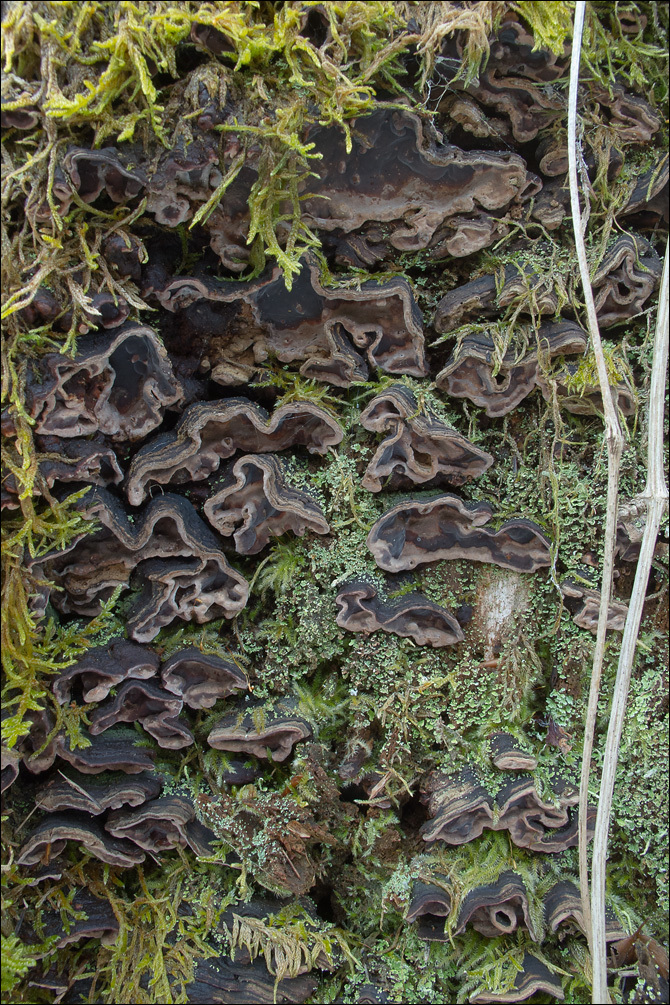
Slo.: krlatni skladovec - Habitat: light, mixed woodland Picea abies and Fagus sylvatica dominant; almost flat terrain; calcareous, skeletal ground; half shade, quite humid place; partly protected from direct rain by tree canopies; average precipitations ~ 3.000 mm/year, average temperature 6 - 8 deg C, elevation 625 m (2.050 feet), alpine phytogeographical region.Substratum: highly disintegrated, moss and lichen covered (most probably) Fagus sylvatica trunk.Comments: Chondrostereum purpureum is quite a common fungus in the Upper Posoje region. It is beautiful when young, but its vivid violaceous or purplish-brown color fades with age although it remains noticable even when very old. This fungus is saprofit but also a parazite and attacts frequently fruit trees, particularly plums, causing serious damages. Simptom of an infection are that tree leaves become silvery (note its English name!).Pilei effuse-reflexed and confluent, individual up to 6 cm wide and up to 2.3 cm off the substratum, from 1 to 2 mm thin, hymenium up to 0.5 thick, context with a dark, thin line under the tomentum; smell distinct, like radish or chemicals, taste unpleasant, on chemicals; SP abundant, whitish-yellowish-beige, between oac900 and oac851.Spores smooth. Dimensions: 4,9 [5,4 ; 5,6] 6,1 x 2,5 [2,7 ; 2,8] 3,1 microns; Q = 1,7 [1,9 ; 2] 2,3; N = 40; C = 95%; Me = 5,5 x 2,8 microns; Qe = 2. Cystidia large, mostly spindle shaped, some encrusted, many thin and elongated at the top, numerous, apparently thick walled (contradicts to the description in Ref.:2). Cystidia visible with a hand lens like a velvety surface of the hymenium. Olympus CH20, NEA 100x/1.25, magnification 1.000 x, oil, aniline blue (spores); NEA 40x/0.65, magnification 400x (hymenium), in water in vivo. AmScope MA500 digital camera.Herbarium: Mycotheca and lichen herbarium (LJU-Li) of Slovenian Forestry Institute, Vena pot 2, Ljubljana, Index Herbariorum LJFRef.:(1) M. Bon, Parey's Buch der Pilze, Kosmos (2005), p 310. (2) J. Breitenbach, F. Kraenzlin, Eds., Fungi of Switzerland, Vol.2. Verlag Mykologia (1986), p 180. SP 6.5-8/2.5-3.5, (3) G. Kibby, British Boletes, Copyright Geoffrey Kibby (2011), p 318. (4) A. Bernicchia, S.P. Gorjon, Cortitiaceaes .i., Fungi Europaei Vol.12., Edizioni Candusso (2010), p 214. (5) S. Buczacki, Collins Fungi Guide, Collins (2012), p 540.
-
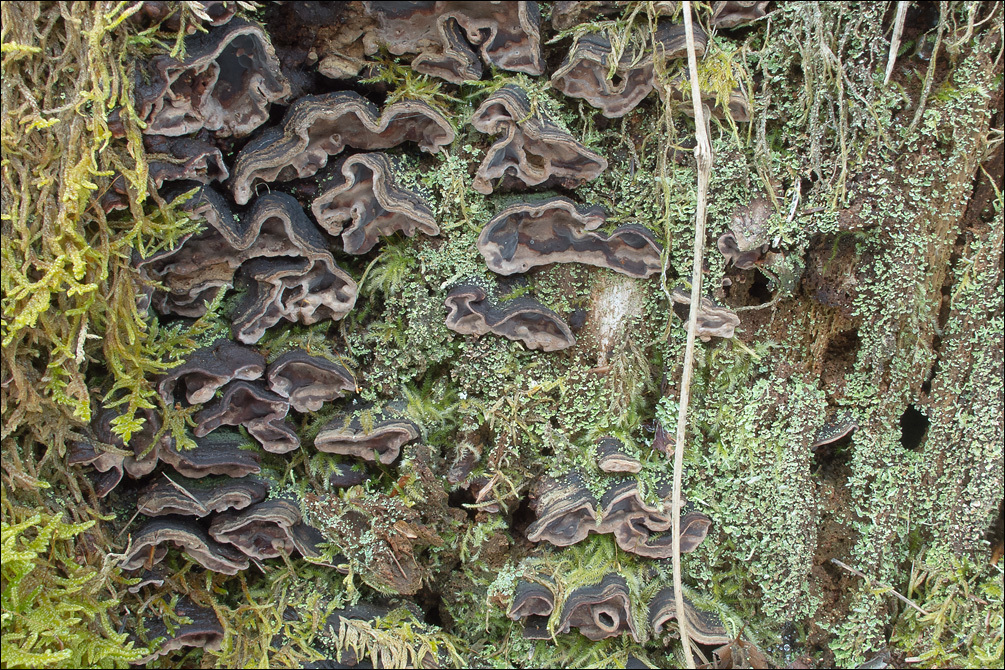
Slo.: krlatni skladovec - Habitat: light, mixed woodland Picea abies and Fagus sylvatica dominant; almost flat terrain; calcareous, skeletal ground; half shade, quite humid place; partly protected from direct rain by tree canopies; average precipitations ~ 3.000 mm/year, average temperature 6 - 8 deg C, elevation 625 m (2.050 feet), alpine phytogeographical region. Substratum: highly disintegrated, moss and lichen covered (most probably) Fagus sylvatica trunk. Comments: Chondrostereum purpureum is quite a common fungus in the Upper Posoje region. It is beautiful when young, but its vivid violaceous or purplish-brown color fades with age although it remains noticable even when very old. This fungus is saprofit but also a parazite and attacts frequently fruit trees, particularly plums, causing serious damages. Simptom of an infection are that tree leaves become silvery (note its English name!). Pilei effuse-reflexed and confluent, individual up to 6 cm wide and up to 2.3 cm off the substratum, from 1 to 2 mm thin, hymenium up to 0.5 thick, context with a dark, thin line under the tomentum; smell distinct, like radish or chemicals, taste unpleasant, on chemicals; SP abundant, whitish-yellowish-beige, between oac900 and oac851. Spores smooth. Dimensions: 4,9 [5,4 ; 5,6] 6,1 x 2,5 [2,7 ; 2,8] 3,1 microns; Q = 1,7 [1,9 ; 2] 2,3; N = 40; C = 95%; Me = 5,5 x 2,8 microns; Qe = 2. Cystidia large, mostly spindle shaped, some encrusted, many thin and elongated at the top, numerous, apparently thick walled (contradicts to the description in Ref.:2). Cystidia visible with a hand lens like a velvety surface of the hymenium. Olympus CH20, NEA 100x/1.25, magnification 1.000 x, oil, aniline blue (spores); NEA 40x/0.65, magnification 400x (hymenium), in water in vivo. AmScope MA500 digital camera. Herbarium: Mycotheca and lichen herbarium (LJU-Li) of Slovenian Forestry Institute, Vena pot 2, Ljubljana, Index Herbariorum LJF Ref.: (1) M. Bon, Parey's Buch der Pilze, Kosmos (2005), p 310. (2) J. Breitenbach, F. Kraenzlin, Eds., Fungi of Switzerland, Vol.2. Verlag Mykologia (1986), p 180. SP 6.5-8/2.5-3.5, (3) G. Kibby, British Boletes, Copyright Geoffrey Kibby (2011), p 318. (4) A. Bernicchia, S.P. Gorjon, Cortitiaceaes .i., Fungi Europaei Vol.12., Edizioni Candusso (2010), p 214. (5) S. Buczacki, Collins Fungi Guide, Collins (2012), p 540.
-
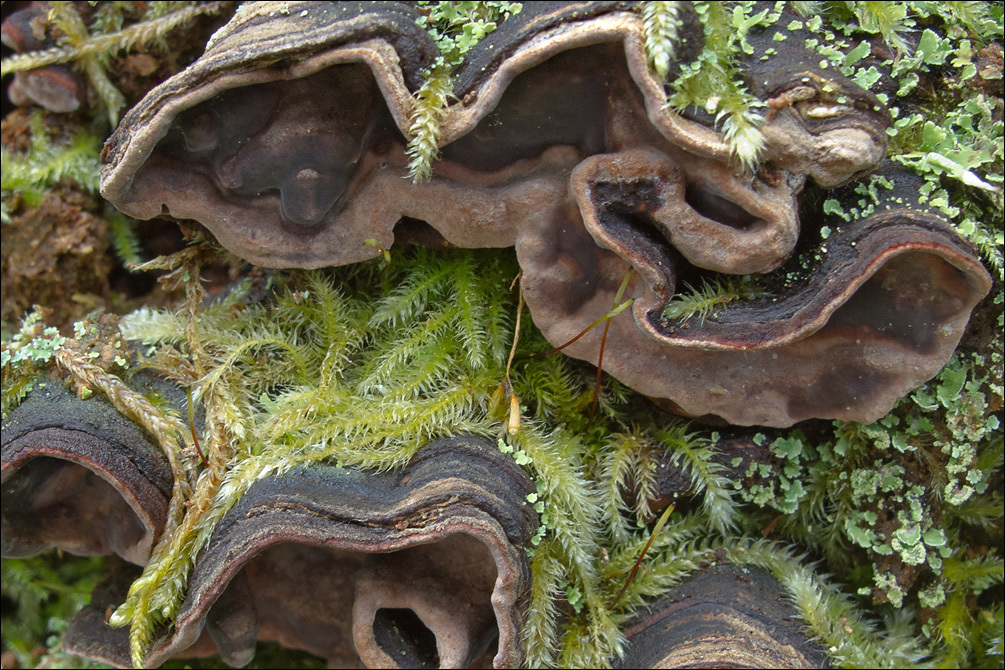
Slo.: krlatni skladovec - Habitat: light, mixed woodland Picea abies and Fagus sylvatica dominant; almost flat terrain; calcareous, skeletal ground; half shade, quite humid place; partly protected from direct rain by tree canopies; average precipitations ~ 3.000 mm/year, average temperature 6 - 8 deg C, elevation 625 m (2.050 feet), alpine phytogeographical region. Substratum: highly disintegrated, moss and lichen covered (most probably) Fagus sylvatica trunk. Comments: Chondrostereum purpureum is quite a common fungus in the Upper Posoje region. It is beautiful when young, but its vivid violaceous or purplish-brown color fades with age although it remains noticable even when very old. This fungus is saprofit but also a parazite and attacts frequently fruit trees, particularly plums, causing serious damages. Simptom of an infection are that tree leaves become silvery (note its English name!). Pilei effuse-reflexed and confluent, individual up to 6 cm wide and up to 2.3 cm off the substratum, from 1 to 2 mm thin, hymenium up to 0.5 thick, context with a dark, thin line under the tomentum; smell distinct, like radish or chemicals, taste unpleasant, on chemicals; SP abundant, whitish-yellowish-beige, between oac900 and oac851. Spores smooth. Dimensions: 4,9 [5,4 ; 5,6] 6,1 x 2,5 [2,7 ; 2,8] 3,1 microns; Q = 1,7 [1,9 ; 2] 2,3; N = 40; C = 95%; Me = 5,5 x 2,8 microns; Qe = 2. Cystidia large, mostly spindle shaped, some encrusted, many thin and elongated at the top, numerous, apparently thick walled (contradicts to the description in Ref.:2). Cystidia visible with a hand lens like a velvety surface of the hymenium. Olympus CH20, NEA 100x/1.25, magnification 1.000 x, oil, aniline blue (spores); NEA 40x/0.65, magnification 400x (hymenium), in water in vivo. AmScope MA500 digital camera. Herbarium: Mycotheca and lichen herbarium (LJU-Li) of Slovenian Forestry Institute, Vena pot 2, Ljubljana, Index Herbariorum LJF Ref.: (1) M. Bon, Parey's Buch der Pilze, Kosmos (2005), p 310. (2) J. Breitenbach, F. Kraenzlin, Eds., Fungi of Switzerland, Vol.2. Verlag Mykologia (1986), p 180. SP 6.5-8/2.5-3.5, (3) G. Kibby, British Boletes, Copyright Geoffrey Kibby (2011), p 318. (4) A. Bernicchia, S.P. Gorjon, Cortitiaceaes .i., Fungi Europaei Vol.12., Edizioni Candusso (2010), p 214. (5) S. Buczacki, Collins Fungi Guide, Collins (2012), p 540.
-
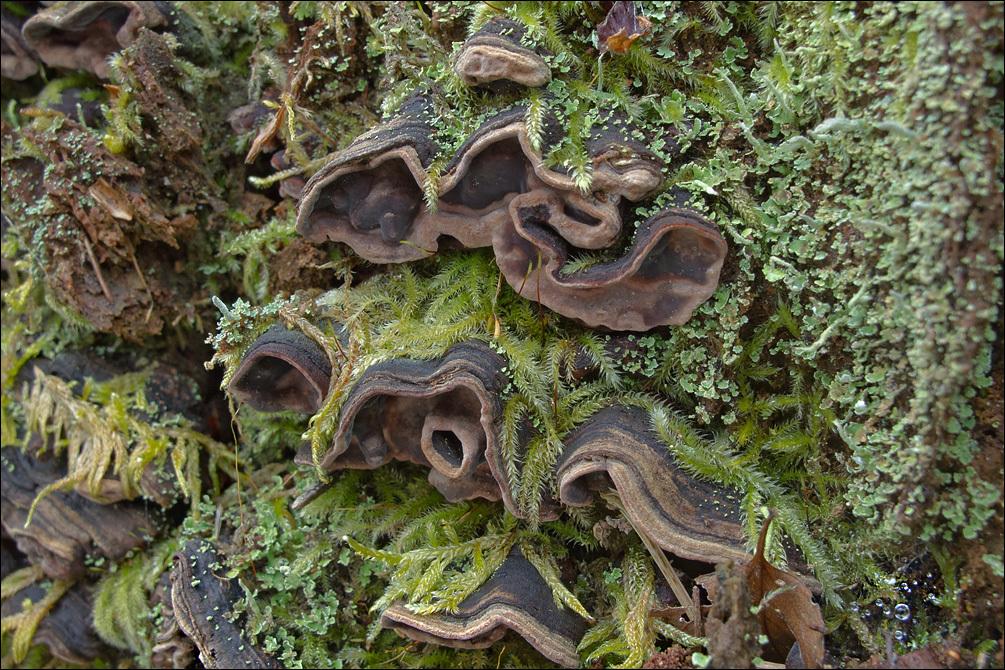
Slo.: krlatni skladovec - Habitat: light, mixed woodland Picea abies and Fagus sylvatica dominant; almost flat terrain; calcareous, skeletal ground; half shade, quite humid place; partly protected from direct rain by tree canopies; average precipitations ~ 3.000 mm/year, average temperature 6 - 8 deg C, elevation 625 m (2.050 feet), alpine phytogeographical region. Substratum: highly disintegrated, moss and lichen covered (most probably) Fagus sylvatica trunk. Comments: Chondrostereum purpureum is quite a common fungus in the Upper Posoje region. It is beautiful when young, but its vivid violaceous or purplish-brown color fades with age although it remains noticable even when very old. This fungus is saprofit but also a parazite and attacts frequently fruit trees, particularly plums, causing serious damages. Simptom of an infection are that tree leaves become silvery (note its English name!). Pilei effuse-reflexed and confluent, individual up to 6 cm wide and up to 2.3 cm off the substratum, from 1 to 2 mm thin, hymenium up to 0.5 thick, context with a dark, thin line under the tomentum; smell distinct, like radish or chemicals, taste unpleasant, on chemicals; SP abundant, whitish-yellowish-beige, between oac900 and oac851. Spores smooth. Dimensions: 4,9 [5,4 ; 5,6] 6,1 x 2,5 [2,7 ; 2,8] 3,1 microns; Q = 1,7 [1,9 ; 2] 2,3; N = 40; C = 95%; Me = 5,5 x 2,8 microns; Qe = 2. Cystidia large, mostly spindle shaped, some encrusted, many thin and elongated at the top, numerous, apparently thick walled (contradicts to the description in Ref.:2). Cystidia visible with a hand lens like a velvety surface of the hymenium. Olympus CH20, NEA 100x/1.25, magnification 1.000 x, oil, aniline blue (spores); NEA 40x/0.65, magnification 400x (hymenium), in water in vivo. AmScope MA500 digital camera. Herbarium: Mycotheca and lichen herbarium (LJU-Li) of Slovenian Forestry Institute, Vena pot 2, Ljubljana, Index Herbariorum LJF Ref.: (1) M. Bon, Parey's Buch der Pilze, Kosmos (2005), p 310. (2) J. Breitenbach, F. Kraenzlin, Eds., Fungi of Switzerland, Vol.2. Verlag Mykologia (1986), p 180. SP 6.5-8/2.5-3.5, (3) G. Kibby, British Boletes, Copyright Geoffrey Kibby (2011), p 318. (4) A. Bernicchia, S.P. Gorjon, Cortitiaceaes .i., Fungi Europaei Vol.12., Edizioni Candusso (2010), p 214. (5) S. Buczacki, Collins Fungi Guide, Collins (2012), p 540.
-
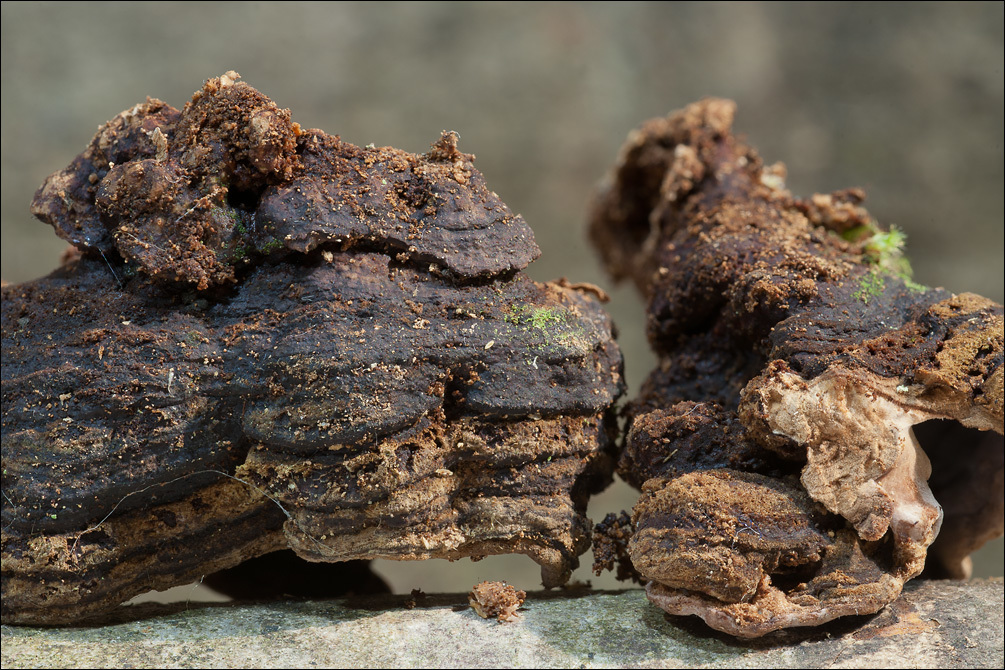
Slo.: krlatni skladovec - Habitat: light, mixed woodland Picea abies and Fagus sylvatica dominant; almost flat terrain; calcareous, skeletal ground; half shade, quite humid place; partly protected from direct rain by tree canopies; average precipitations ~ 3.000 mm/year, average temperature 6 - 8 deg C, elevation 625 m (2.050 feet), alpine phytogeographical region. Substratum: highly disintegrated, moss and lichen covered (most probably) Fagus sylvatica trunk. Comments: Chondrostereum purpureum is quite a common fungus in the Upper Posoje region. It is beautiful when young, but its vivid violaceous or purplish-brown color fades with age although it remains noticable even when very old. This fungus is saprofit but also a parazite and attacts frequently fruit trees, particularly plums, causing serious damages. Simptom of an infection are that tree leaves become silvery (note its English name!). Pilei effuse-reflexed and confluent, individual up to 6 cm wide and up to 2.3 cm off the substratum, from 1 to 2 mm thin, hymenium up to 0.5 thick, context with a dark, thin line under the tomentum; smell distinct, like radish or chemicals, taste unpleasant, on chemicals; SP abundant, whitish-yellowish-beige, between oac900 and oac851. Spores smooth. Dimensions: 4,9 [5,4 ; 5,6] 6,1 x 2,5 [2,7 ; 2,8] 3,1 microns; Q = 1,7 [1,9 ; 2] 2,3; N = 40; C = 95%; Me = 5,5 x 2,8 microns; Qe = 2. Cystidia large, mostly spindle shaped, some encrusted, many thin and elongated at the top, numerous, apparently thick walled (contradicts to the description in Ref.:2). Cystidia visible with a hand lens like a velvety surface of the hymenium. Olympus CH20, NEA 100x/1.25, magnification 1.000 x, oil, aniline blue (spores); NEA 40x/0.65, magnification 400x (hymenium), in water in vivo. AmScope MA500 digital camera. Herbarium: Mycotheca and lichen herbarium (LJU-Li) of Slovenian Forestry Institute, Vena pot 2, Ljubljana, Index Herbariorum LJF Ref.: (1) M. Bon, Parey's Buch der Pilze, Kosmos (2005), p 310. (2) J. Breitenbach, F. Kraenzlin, Eds., Fungi of Switzerland, Vol.2. Verlag Mykologia (1986), p 180. SP 6.5-8/2.5-3.5, (3) G. Kibby, British Boletes, Copyright Geoffrey Kibby (2011), p 318. (4) A. Bernicchia, S.P. Gorjon, Cortitiaceaes .i., Fungi Europaei Vol.12., Edizioni Candusso (2010), p 214. (5) S. Buczacki, Collins Fungi Guide, Collins (2012), p 540.
-

Slo.: krlatni skladovec - Habitat: light, mixed woodland Picea abies and Fagus sylvatica dominant; almost flat terrain; calcareous, skeletal ground; half shade, quite humid place; partly protected from direct rain by tree canopies; average precipitations ~ 3.000 mm/year, average temperature 6 - 8 deg C, elevation 625 m (2.050 feet), alpine phytogeographical region. Substratum: highly disintegrated, moss and lichen covered (most probably) Fagus sylvatica trunk. Comments: Chondrostereum purpureum is quite a common fungus in the Upper Posoje region. It is beautiful when young, but its vivid violaceous or purplish-brown color fades with age although it remains noticable even when very old. This fungus is saprofit but also a parazite and attacts frequently fruit trees, particularly plums, causing serious damages. Simptom of an infection are that tree leaves become silvery (note its English name!). Pilei effuse-reflexed and confluent, individual up to 6 cm wide and up to 2.3 cm off the substratum, from 1 to 2 mm thin, hymenium up to 0.5 thick, context with a dark, thin line under the tomentum; smell distinct, like radish or chemicals, taste unpleasant, on chemicals; SP abundant, whitish-yellowish-beige, between oac900 and oac851. Spores smooth. Dimensions: 4,9 [5,4 ; 5,6] 6,1 x 2,5 [2,7 ; 2,8] 3,1 microns; Q = 1,7 [1,9 ; 2] 2,3; N = 40; C = 95%; Me = 5,5 x 2,8 microns; Qe = 2. Cystidia large, mostly spindle shaped, some encrusted, many thin and elongated at the top, numerous, apparently thick walled (contradicts to the description in Ref.:2). Cystidia visible with a hand lens like a velvety surface of the hymenium. Olympus CH20, NEA 100x/1.25, magnification 1.000 x, oil, aniline blue (spores); NEA 40x/0.65, magnification 400x (hymenium), in water in vivo. AmScope MA500 digital camera. Herbarium: Mycotheca and lichen herbarium (LJU-Li) of Slovenian Forestry Institute, Vena pot 2, Ljubljana, Index Herbariorum LJF Ref.: (1) M. Bon, Parey's Buch der Pilze, Kosmos (2005), p 310. (2) J. Breitenbach, F. Kraenzlin, Eds., Fungi of Switzerland, Vol.2. Verlag Mykologia (1986), p 180. SP 6.5-8/2.5-3.5, (3) G. Kibby, British Boletes, Copyright Geoffrey Kibby (2011), p 318. (4) A. Bernicchia, S.P. Gorjon, Cortitiaceaes .i., Fungi Europaei Vol.12., Edizioni Candusso (2010), p 214. (5) S. Buczacki, Collins Fungi Guide, Collins (2012), p 540.
-
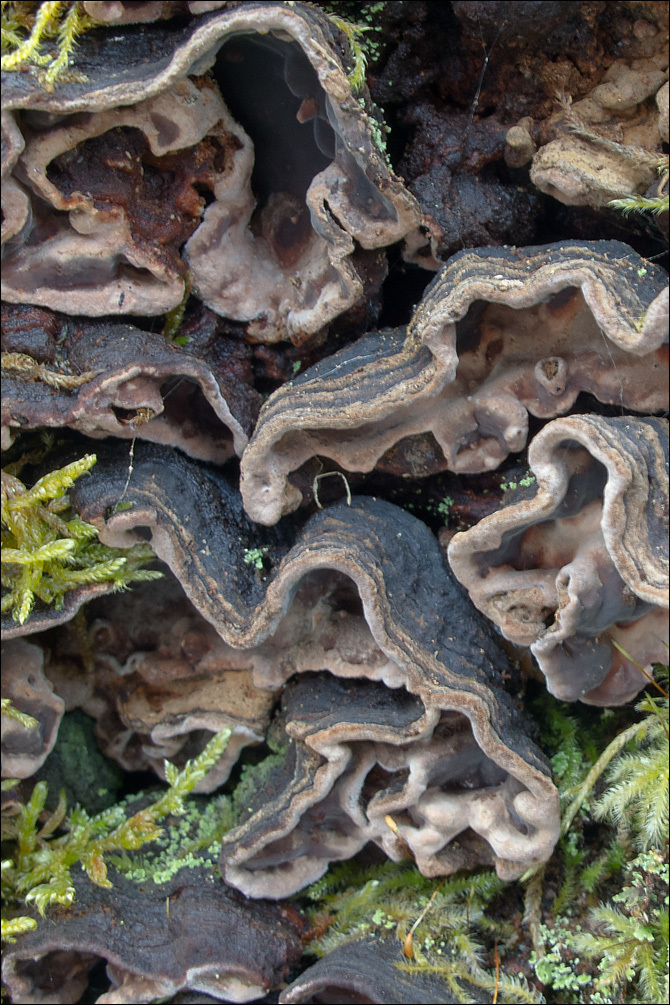
Slo.: krlatni skladovec - Habitat: light, mixed woodland Picea abies and Fagus sylvatica dominant; almost flat terrain; calcareous, skeletal ground; half shade, quite humid place; partly protected from direct rain by tree canopies; average precipitations ~ 3.000 mm/year, average temperature 6 - 8 deg C, elevation 625 m (2.050 feet), alpine phytogeographical region. Substratum: highly disintegrated, moss and lichen covered (most probably) Fagus sylvatica trunk. Comments: Chondrostereum purpureum is quite a common fungus in the Upper Posoje region. It is beautiful when young, but its vivid violaceous or purplish-brown color fades with age although it remains noticable even when very old. This fungus is saprofit but also a parazite and attacts frequently fruit trees, particularly plums, causing serious damages. Simptom of an infection are that tree leaves become silvery (note its English name!). Pilei effuse-reflexed and confluent, individual up to 6 cm wide and up to 2.3 cm off the substratum, from 1 to 2 mm thin, hymenium up to 0.5 thick, context with a dark, thin line under the tomentum; smell distinct, like radish or chemicals, taste unpleasant, on chemicals; SP abundant, whitish-yellowish-beige, between oac900 and oac851. Spores smooth. Dimensions: 4,9 [5,4 ; 5,6] 6,1 x 2,5 [2,7 ; 2,8] 3,1 microns; Q = 1,7 [1,9 ; 2] 2,3; N = 40; C = 95%; Me = 5,5 x 2,8 microns; Qe = 2. Cystidia large, mostly spindle shaped, some encrusted, many thin and elongated at the top, numerous, apparently thick walled (contradicts to the description in Ref.:2). Cystidia visible with a hand lens like a velvety surface of the hymenium. Olympus CH20, NEA 100x/1.25, magnification 1.000 x, oil, aniline blue (spores); NEA 40x/0.65, magnification 400x (hymenium), in water in vivo. AmScope MA500 digital camera. Herbarium: Mycotheca and lichen herbarium (LJU-Li) of Slovenian Forestry Institute, Vena pot 2, Ljubljana, Index Herbariorum LJF Ref.: (1) M. Bon, Parey's Buch der Pilze, Kosmos (2005), p 310. (2) J. Breitenbach, F. Kraenzlin, Eds., Fungi of Switzerland, Vol.2. Verlag Mykologia (1986), p 180. SP 6.5-8/2.5-3.5, (3) G. Kibby, British Boletes, Copyright Geoffrey Kibby (2011), p 318. (4) A. Bernicchia, S.P. Gorjon, Cortitiaceaes .i., Fungi Europaei Vol.12., Edizioni Candusso (2010), p 214. (5) S. Buczacki, Collins Fungi Guide, Collins (2012), p 540.
-

Slo.: krlatni skladovec - Habitat: light, mixed woodland Picea abies and Fagus sylvatica dominant; almost flat terrain; calcareous, skeletal ground; half shade, quite humid place; partly protected from direct rain by tree canopies; average precipitations ~ 3.000 mm/year, average temperature 6 - 8 deg C, elevation 625 m (2.050 feet), alpine phytogeographical region. Substratum: highly disintegrated, moss and lichen covered (most probably) Fagus sylvatica trunk. Comments: Chondrostereum purpureum is quite a common fungus in the Upper Posoje region. It is beautiful when young, but its vivid violaceous or purplish-brown color fades with age although it remains noticable even when very old. This fungus is saprofit but also a parazite and attacts frequently fruit trees, particularly plums, causing serious damages. Simptom of an infection are that tree leaves become silvery (note its English name!). Pilei effuse-reflexed and confluent, individual up to 6 cm wide and up to 2.3 cm off the substratum, from 1 to 2 mm thin, hymenium up to 0.5 thick, context with a dark, thin line under the tomentum; smell distinct, like radish or chemicals, taste unpleasant, on chemicals; SP abundant, whitish-yellowish-beige, between oac900 and oac851. Spores smooth. Dimensions: 4,9 [5,4 ; 5,6] 6,1 x 2,5 [2,7 ; 2,8] 3,1 microns; Q = 1,7 [1,9 ; 2] 2,3; N = 40; C = 95%; Me = 5,5 x 2,8 microns; Qe = 2. Cystidia large, mostly spindle shaped, some encrusted, many thin and elongated at the top, numerous, apparently thick walled (contradicts to the description in Ref.:2). Cystidia visible with a hand lens like a velvety surface of the hymenium. Olympus CH20, NEA 100x/1.25, magnification 1.000 x, oil, aniline blue (spores); NEA 40x/0.65, magnification 400x (hymenium), in water in vivo. AmScope MA500 digital camera. Herbarium: Mycotheca and lichen herbarium (LJU-Li) of Slovenian Forestry Institute, Vena pot 2, Ljubljana, Index Herbariorum LJF Ref.: (1) M. Bon, Parey's Buch der Pilze, Kosmos (2005), p 310. (2) J. Breitenbach, F. Kraenzlin, Eds., Fungi of Switzerland, Vol.2. Verlag Mykologia (1986), p 180. SP 6.5-8/2.5-3.5, (3) G. Kibby, British Boletes, Copyright Geoffrey Kibby (2011), p 318. (4) A. Bernicchia, S.P. Gorjon, Cortitiaceaes .i., Fungi Europaei Vol.12., Edizioni Candusso (2010), p 214. (5) S. Buczacki, Collins Fungi Guide, Collins (2012), p 540.
-

Slo.: krlatni skladovec - Habitat: light, mixed woodland Picea abies and Fagus sylvatica dominant; almost flat terrain; calcareous, skeletal ground; half shade, quite humid place; partly protected from direct rain by tree canopies; average precipitations ~ 3.000 mm/year, average temperature 6 - 8 deg C, elevation 625 m (2.050 feet), alpine phytogeographical region. Substratum: highly disintegrated, moss and lichen covered (most probably) Fagus sylvatica trunk. Comments: Chondrostereum purpureum is quite a common fungus in the Upper Posoje region. It is beautiful when young, but its vivid violaceous or purplish-brown color fades with age although it remains noticable even when very old. This fungus is saprofit but also a parazite and attacts frequently fruit trees, particularly plums, causing serious damages. Simptom of an infection are that tree leaves become silvery (note its English name!). Pilei effuse-reflexed and confluent, individual up to 6 cm wide and up to 2.3 cm off the substratum, from 1 to 2 mm thin, hymenium up to 0.5 thick, context with a dark, thin line under the tomentum; smell distinct, like radish or chemicals, taste unpleasant, on chemicals; SP abundant, whitish-yellowish-beige, between oac900 and oac851. Spores smooth. Dimensions: 4,9 [5,4 ; 5,6] 6,1 x 2,5 [2,7 ; 2,8] 3,1 microns; Q = 1,7 [1,9 ; 2] 2,3; N = 40; C = 95%; Me = 5,5 x 2,8 microns; Qe = 2. Cystidia large, mostly spindle shaped, some encrusted, many thin and elongated at the top, numerous, apparently thick walled (contradicts to the description in Ref.:2). Cystidia visible with a hand lens like a velvety surface of the hymenium. Olympus CH20, NEA 100x/1.25, magnification 1.000 x, oil, aniline blue (spores); NEA 40x/0.65, magnification 400x (hymenium), in water in vivo. AmScope MA500 digital camera. Herbarium: Mycotheca and lichen herbarium (LJU-Li) of Slovenian Forestry Institute, Vena pot 2, Ljubljana, Index Herbariorum LJF Ref.: (1) M. Bon, Parey's Buch der Pilze, Kosmos (2005), p 310. (2) J. Breitenbach, F. Kraenzlin, Eds., Fungi of Switzerland, Vol.2. Verlag Mykologia (1986), p 180. SP 6.5-8/2.5-3.5, (3) G. Kibby, British Boletes, Copyright Geoffrey Kibby (2011), p 318. (4) A. Bernicchia, S.P. Gorjon, Cortitiaceaes .i., Fungi Europaei Vol.12., Edizioni Candusso (2010), p 214. (5) S. Buczacki, Collins Fungi Guide, Collins (2012), p 540.
-
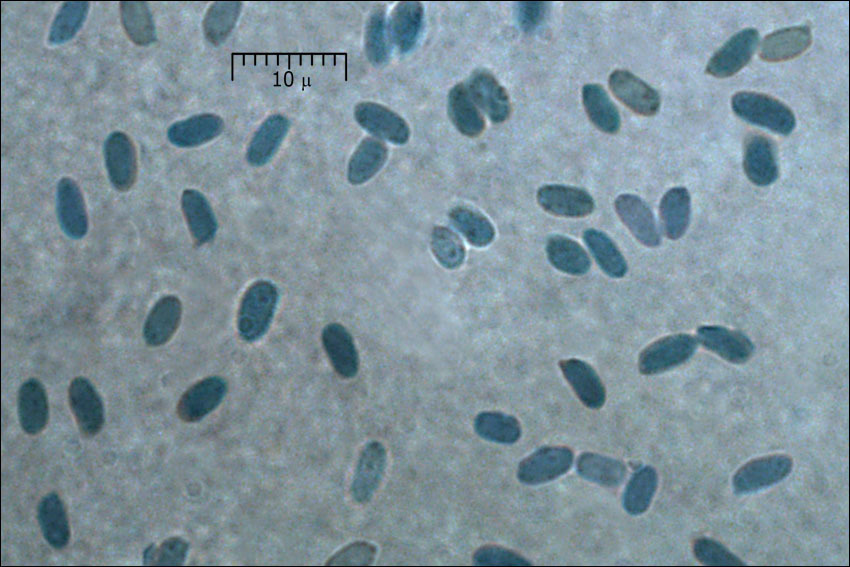
Slo.: krlatni skladovec - Habitat: light, mixed woodland Picea abies and Fagus sylvatica dominant; almost flat terrain; calcareous, skeletal ground; half shade, quite humid place; partly protected from direct rain by tree canopies; average precipitations ~ 3.000 mm/year, average temperature 6 - 8 deg C, elevation 625 m (2.050 feet), alpine phytogeographical region. Substratum: highly disintegrated, moss and lichen covered (most probably) Fagus sylvatica trunk. Comments: Chondrostereum purpureum is quite a common fungus in the Upper Posoje region. It is beautiful when young, but its vivid violaceous or purplish-brown color fades with age although it remains noticable even when very old. This fungus is saprofit but also a parazite and attacts frequently fruit trees, particularly plums, causing serious damages. Simptom of an infection are that tree leaves become silvery (note its English name!). Pilei effuse-reflexed and confluent, individual up to 6 cm wide and up to 2.3 cm off the substratum, from 1 to 2 mm thin, hymenium up to 0.5 thick, context with a dark, thin line under the tomentum; smell distinct, like radish or chemicals, taste unpleasant, on chemicals; SP abundant, whitish-yellowish-beige, between oac900 and oac851. Spores smooth. Dimensions: 4,9 [5,4 ; 5,6] 6,1 x 2,5 [2,7 ; 2,8] 3,1 microns; Q = 1,7 [1,9 ; 2] 2,3; N = 40; C = 95%; Me = 5,5 x 2,8 microns; Qe = 2. Cystidia large, mostly spindle shaped, some encrusted, many thin and elongated at the top, numerous, apparently thick walled (contradicts to the description in Ref.:2). Cystidia visible with a hand lens like a velvety surface of the hymenium. Olympus CH20, NEA 100x/1.25, magnification 1.000 x, oil, aniline blue (spores); NEA 40x/0.65, magnification 400x (hymenium), in water in vivo. AmScope MA500 digital camera. Herbarium: Mycotheca and lichen herbarium (LJU-Li) of Slovenian Forestry Institute, Vena pot 2, Ljubljana, Index Herbariorum LJF Ref.: (1) M. Bon, Parey's Buch der Pilze, Kosmos (2005), p 310. (2) J. Breitenbach, F. Kraenzlin, Eds., Fungi of Switzerland, Vol.2. Verlag Mykologia (1986), p 180. SP 6.5-8/2.5-3.5, (3) G. Kibby, British Boletes, Copyright Geoffrey Kibby (2011), p 318. (4) A. Bernicchia, S.P. Gorjon, Cortitiaceaes .i., Fungi Europaei Vol.12., Edizioni Candusso (2010), p 214. (5) S. Buczacki, Collins Fungi Guide, Collins (2012), p 540.
-
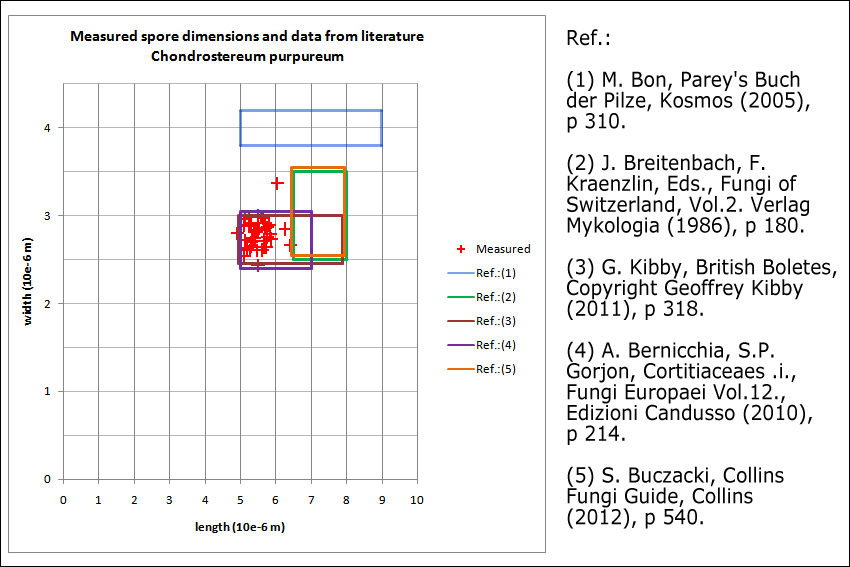
Slo.: krlatni skladovec - Habitat: light, mixed woodland Picea abies and Fagus sylvatica dominant; almost flat terrain; calcareous, skeletal ground; half shade, quite humid place; partly protected from direct rain by tree canopies; average precipitations ~ 3.000 mm/year, average temperature 6 - 8 deg C, elevation 625 m (2.050 feet), alpine phytogeographical region. Substratum: highly disintegrated, moss and lichen covered (most probably) Fagus sylvatica trunk. Comments: Chondrostereum purpureum is quite a common fungus in the Upper Posoje region. It is beautiful when young, but its vivid violaceous or purplish-brown color fades with age although it remains noticable even when very old. This fungus is saprofit but also a parazite and attacts frequently fruit trees, particularly plums, causing serious damages. Simptom of an infection are that tree leaves become silvery (note its English name!). Pilei effuse-reflexed and confluent, individual up to 6 cm wide and up to 2.3 cm off the substratum, from 1 to 2 mm thin, hymenium up to 0.5 thick, context with a dark, thin line under the tomentum; smell distinct, like radish or chemicals, taste unpleasant, on chemicals; SP abundant, whitish-yellowish-beige, between oac900 and oac851. Spores smooth. Dimensions: 4,9 [5,4 ; 5,6] 6,1 x 2,5 [2,7 ; 2,8] 3,1 microns; Q = 1,7 [1,9 ; 2] 2,3; N = 40; C = 95%; Me = 5,5 x 2,8 microns; Qe = 2. Cystidia large, mostly spindle shaped, some encrusted, many thin and elongated at the top, numerous, apparently thick walled (contradicts to the description in Ref.:2). Cystidia visible with a hand lens like a velvety surface of the hymenium. Olympus CH20, NEA 100x/1.25, magnification 1.000 x, oil, aniline blue (spores); NEA 40x/0.65, magnification 400x (hymenium), in water in vivo. AmScope MA500 digital camera. Herbarium: Mycotheca and lichen herbarium (LJU-Li) of Slovenian Forestry Institute, Vena pot 2, Ljubljana, Index Herbariorum LJF Ref.: (1) M. Bon, Parey's Buch der Pilze, Kosmos (2005), p 310. (2) J. Breitenbach, F. Kraenzlin, Eds., Fungi of Switzerland, Vol.2. Verlag Mykologia (1986), p 180. SP 6.5-8/2.5-3.5, (3) G. Kibby, British Boletes, Copyright Geoffrey Kibby (2011), p 318. (4) A. Bernicchia, S.P. Gorjon, Cortitiaceaes .i., Fungi Europaei Vol.12., Edizioni Candusso (2010), p 214. (5) S. Buczacki, Collins Fungi Guide, Collins (2012), p 540.
-
2001 California Academy of Sciences
CalPhotos


